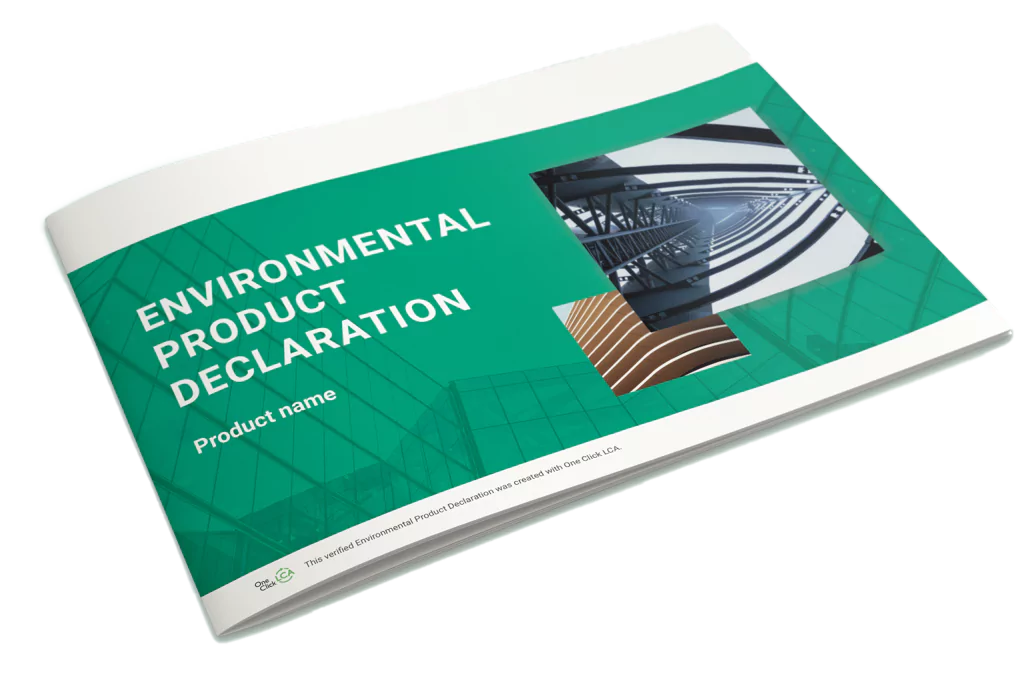
Source: One Click LCA
Don’t let these common misunderstandings slow down your progress
Environmental Product Declarations (or EPDs) are a kind of environmental label for your products. Used by certification schemes, investors and green building professionals alike, EPDs are playing an increasingly important role in construction. Indeed, you may already be seeing EPDs specified for your projects or in tender processes. But are you confident you know what’s involved? One Click LCA is on a mission to make carbon transparency understandable and accessible to all. This article aims to dispel some of the most widespread misconceptions about EPDs and product carbon assessments.
1. Creating an EPD is costly and takes too long
Creating an EPD does require an initial investment of time and money, but this is soon returned many times over by the competitive edge it gives your product. Product carbon information is becoming a prerequisite for large-scale projects, so products with the right data – whether in full EPD form or as a carbon assessment – will be favoured over competitors. By handling the third party verification and publication, and by streamlining the initial data collection, One Click LCA Pre-verified EPD Generator dramatically reduces the time and costs involved too. It cuts down the time it takes to create an EPD from several months to a couple of weeks. If you just want to generate a carbon footprint for your product – without assessing other types of environmental impacts and without verification or publication – One Click LCA Product Carbon Tool will do just that.
2. EPDs require all kinds of data that I don’t have
There is a lot of flexibility in how you can obtain the required data. For example, you can use your subcontractor’s EPDs or generic EPDs for the same product types. If the raw material that you wish to use doesn’t have its own EPD, and the manufacturer doesn’t plan to create one any time soon, you can still use the desired material. All you need to do is to find the right generic dataset for it. One Click LCA provides access to the Ecoinvent database and our database containing over 85,000 data points of both generic data and EPDs.
3. I won’t be able to understand the results
An EPD document does contain complex information, but it is not designed to be used in its raw form. One Click LCA’s platform transforms EPD data into easily understandable results that can be used to compare different material or building designs. Also, many manufacturers use EPDs to benchmark their progress on the path to improved sustainability. Even without doing a deep dive into the data, it is possible to see which areas are causing the biggest impacts, e.g. transportation or energy consumption during processing. It’s then possible to target those areas for improvement.
4. Generating an EPD will expose sensitive corporate information
It is a common misconception that manufacturers are required to publicly disclose details of their manufacturing process or supply chain in order to create an EPD. But this is not the case. All that is needed is the life-cycle analysis data, not the specific details. Generating an EPD could be likened to an organic bread company gaining certification. The certification reassures consumers that they have followed organic practices but does not reveal ingredients to competitors.
5. I can’t create an EPD because there are no verifiers in my country
It’s widely thought this is an issue but in fact you don’t need to use a verifier based in your country. Whether in the next town or the other side of the globe, all that matters is that verification is based on the appropriate EPD standard. For example, if you sell your products within the EU, your EPD will need to be verified in compliance with the European standard EN 15804 +A2. Beyond Europe, the usual standard is ISO 21930 or TRACI 2.1 in North America. With the One Click LCA Pre-verified EPD Generator and One Click LCA Flexible EPD Tool, you can get results calculated for EN 15804+A1 (for ISO 21930 and backward compatibility), EN 15804+A2 and TRACI 2.1, all generated in the same report. This enables all users to be served by the same EPD that is valid 5 years from the date of publishing. It’s also worth remembering that it’s possible to conduct a product life-cycle assessment and then choose not to verify or publish and EPD. This means you can make your product’s data available to your client, but it will not be published.
6. You have to create a separate EPD for every single product
While EPDs are often used for a specific product, an EPD can also be created for a group of products that all serve the same function – eg floor finishers or insulation. To group more than one of your products into the same EPD, you will need to conduct a separate LCA for each product in the group. If their LCA results have less than 10% variance, then they can all be covered by one EPD.
7. There’s no benefit to me
Hopefully you’ve already seen how creating an EPD can provide your product with a market advantage. Whilst not a requirement for all projects yet, it is likely this will one day become the case. Any project that seeks an EPD credit as part of a green building certification – such as BREEAM or LEED – will require a specified number of materials and products to have an EPD. That’s a big market to miss out on by not investing in an EPD.
8. I can't have an EPD, my product has a large environmental impact!
Certification credits are often earned for transparency rather than low product carbon impact. So, whatever the impact of your product, by making its impact data available, it will be more likely to be chosen for a project seeking certification. The old adage of what you don’t measure you can’t improve is also true here. By conducting product life-cycle or carbon assessments you can identify where the biggest impacts are created and take steps to improve them. One Click LCA Product Carbon Tool enables users to change variables, like mode of transport or materials used, to see where improvements can be made which can then be incorporated into the manufacturing process. Embodied carbon in construction materials contributes 11% to global greenhouse gas emissions and may exceed 230 gigatons by 2060. Decarbonising construction will not happen overnight but, by investing in EPDs, manufacturers can start the journey to more sustainable products.
/Software_highlightimage_EPD%20Generator.webp)

